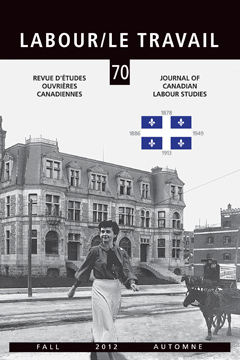Abstract
In February 1913, when a teacher at Montreal’s Aberdeen School made disparaging remarks about her Jewish pupils, five boys called a strike. Hundreds of Jewish children congregated in the park across from the school where they appointed strike leaders, established a negotiating committee, and resolved not to return to class until the teacher apologized. Some of them marched to the Baron de Hirsch Institute and the newspaper office of the Keneder Adler to demand that action be taken. The Aberdeen students showed maturity in their understanding of “the strike” as a strategic response to perceived injustice, their politicization with respect to relations between the Jewish and Anglo-Protestant communities, and class consciousness. The years 1912 and 1913 had been arduous for working-class Jews living along the St-Laurent Street corridor who experienced a lengthy tailors’ strike followed by an economic depression. The youthful strikers were acutely aware of the difficulties of being both working class and Jewish. We argue that the collective actions of the Aberdeen School strikers reveal a close connection to the labour activism of their parents and to the downtown Jewish community. Their response to the teacher’s anti-Semitic comments is an example of the historical agency of children.
En février 1913, à la suite d’insultes antisémites provenant de leur enseignante, cinq garçons de l’école Aberdeen de Montréal ont décidé de faire la grève. Peu de temps après, des centaines d’élèves juifs montréalais se sont réunis au parc en face de l’école. Là, ils ont désigné des leaders, ils ont établi un comité de négociation, et ils ont convenu de ne pas retourner à l’école sans obtenir au préalable des excuses de l’enseignante. Certains grévistes ont également manifesté devant les bureaux de l’institut Baron de Hirsch et devant ceux du journal yiddish Keneder Adler pour afin d’obtenir appui à leur cause. Enfin, dans la foulée de ces événements, les élèves de l’école Aberdeen ont démontré une compréhension profonde de « la grève » comme réponse stratégique à l’injustice, et aussi de la politique entre les communautés juive et protestante. Les années 1912–13 furent très difficiles pour les familles juives de la classe ouvrière à Montréal, mentionnons notamment, la grève des tailleurs suivie par la dépression économique. Les jeunes grévistes ont compris parfaitement ce que voulait dire être à la fois juif et de la classe ouvrière. Selon nous, la grève à l’école Aberdeen est une expression du syndicalisme des parents des grévistes et de l’injustice senti par toute la communauté immigrante juive. Les actions de ces élèves confrontés par l’antisémitisme représentent un exemple manifeste de la capacité d’agir des enfants.
